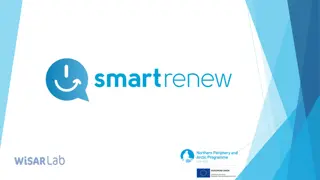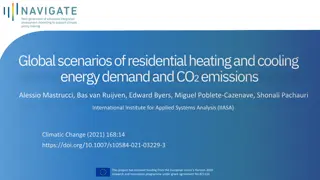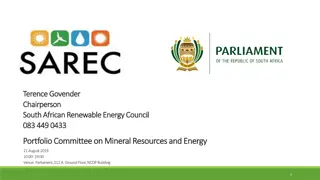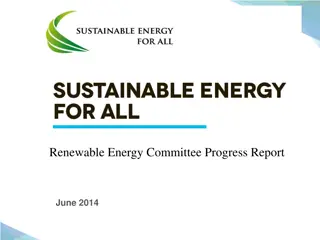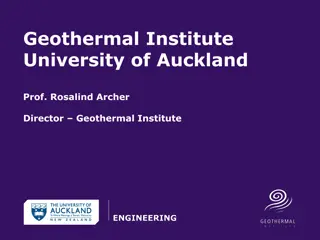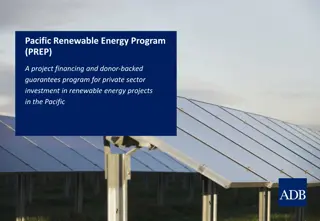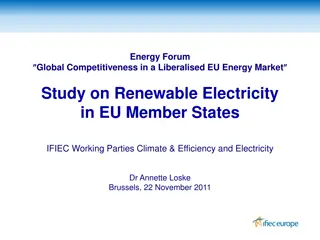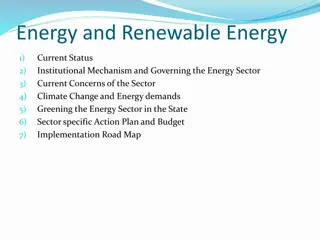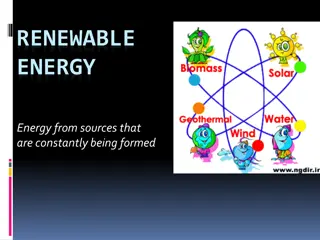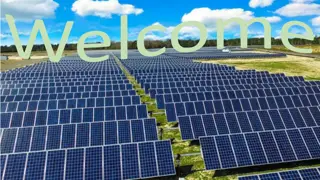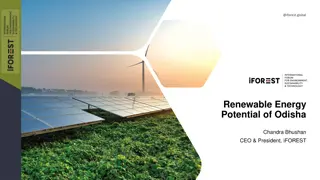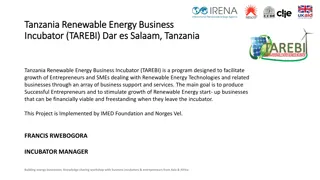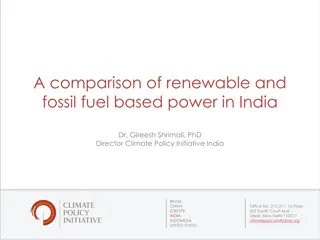SMARTrenew: Smarter Renewable Energy and Heating Management Project
SMARTrenew is a collaborative project focusing on improving energy efficiency and storage in Arctic and Northern rural areas. Led by Dr. Nick Timmons, it aims to address challenges such as low population densities and reliance on fossil fuels. The project will implement smart renewable energy solutions and evaluate their impact in different regions, ultimately creating smarter energy action plans.
Download Presentation

Please find below an Image/Link to download the presentation.
The content on the website is provided AS IS for your information and personal use only. It may not be sold, licensed, or shared on other websites without obtaining consent from the author.If you encounter any issues during the download, it is possible that the publisher has removed the file from their server.
You are allowed to download the files provided on this website for personal or commercial use, subject to the condition that they are used lawfully. All files are the property of their respective owners.
The content on the website is provided AS IS for your information and personal use only. It may not be sold, licensed, or shared on other websites without obtaining consent from the author.
E N D
Presentation Transcript
SMARTrenew: Smarter Renewable Energy and Heating Management for Arctic and Northern Rural Territories Project Lead: Dr. Nick Timmons, WiSAR Lab, LyIT Funder: Interreg NPA Value: 1,65 million Duration: 3 years, start date Oct 2018 Partner Counties and Organisations: Ireland: Finland: N. Ireland: Faroe Islands: Environment Agency Ireland: Donegal County Council Norway: Norut Research Centre, Narvik WiSAR Lab, Letterkenny Institute of Technology Oulu University of Applied Science Derry City & Strabane District Council Iceland National Energy Authority, Akureyri
SMARTrenew: Challenges facing the Northern Periphery and Arctic (NPA) region to be addressed by SMARTrenew: Remote, low population densities, cold climate, with dependency on fossil fuel for heat and energy Poor uptake of smart renewable technology High cost of fossil fuel leading to fuel poverty and insecurity Smart energy storage is underdeveloped with energy being wasted Unrealised benefits of renewable energy from local resources and latest energy research Many existing buildings and energy systems not optimised for energy efficiency or storage Countries are at different levels of renewable energy development and have transferrable skills and knowledge.
SMARTrenew will focus on smart energy and heat storage and the renewable mix Establish a transnational network of countries covering Arctic, Northern, Atlantic, and Islands 1. Build Smart Energy Rural Communities through Stakeholder teams in each region Build NPA Directory of Services and Solutions through transnational knowledge exchange Baseline analysis of smart storage and renewable mix in each region Design and Implement pilots of smart renewable energy storage and renewable mix 2. Storage implementation including water, batteries, and deep underground Renewable mix implementation including, heat/energy from the ocean, solar, wind, biomass Integrate smart management of energy and heat storage for renewable systems in dispersed communities 3. Evaluate impact of energy pilots in each region Disseminate results of energy efficiencies and cost savings through smart storage and renewable mix Devise smarter energy action plans for each region
Borehole Thermal storage in the Faroe Islands Faroe Islands are remote in the middle of the North East Atlantic 93% of the energy use is from imported oil Energy storage is needed for fluctuating new renewable energy sources Around 20% of the total energy is used for space heating Ground source heat pumps are replacing oil burners The Faroese SMARTrenew pilot will pilot the storage of heat in deep ground source heat pump boreholes - Borehole Thermal Energy Storage combined with Water Storage
Off-grid households in the far North - NORUT, Norway There are two families in Lofoten (Arctic Circle) who are aiming for complete off-grid solutions. They are at different stages of implementation. Challenges: Supply of renewable energy during the winter months are really is difficult polar nights! Families use innovative solutions to keep down consumption of electricity and cherry- picking household appliances that use the least amount of energy. Heating and cooking are mostly supplied by wood. Energy storage in form of batteries and hot water tank. Have struggled, washed clothes in local river at times! Project activity: remote monitoring of weather especially, solar, wind, and temperature together with energy consumption, to reach an off-grid solution using optimal mix of renewables. Aims to deliver wintertime comfort and energy reliability with smart renewable mix. Houses will be showcases - off-grid living in the cold north!
Converting Icelands cold areas to other renewables Hot water Parts of Iceland do not benefit from the heat and energy provided by underground hot volcanic water. SMARTrenew has been involved in projects to convert these regions to other renewables away from oil. Initial SMARTrenew work was a study on combining heat from the sea together with biomass to supply DH to town in the more wooded eastern Iceland Seawater Wind Biofuel Diesel Green Grimsey Main pilot project on island of Grimsey off north coast currently which was 100% oil reliant. Conversion renewable mix of biomass, wind, solar and battery storage. Controls Old car batteries have been upcycled, no good for cars, but can still store and generate for low power applications Electric Electric for Heating
Donegal County Council Milford Public Services Centre and Library Renewable Mix/Smart Storage 3no. 42.6 kW Air-to-Water Heat Pumps 6 kW Solar PV Array Pumped Insulation to 50mm Wall Cavity Removal of the dependency on heating oil Providing a smart renewable energy mix Providing smart heating and electric control mix Pilot Project Benefits Innovation Component The first Public Services Centre and Library building in County Donegal to be retrofitted to a B2 Energy Rating incorporating various innovative renewable technologies Estimated Savings: 200,562 kWhrs per annum primarily in thermal savings Estimated Payback: 14 years on initial capital, reduced to 7 years following grant aids
Renewable Energy Within Derry City and Strabane District Council Total Solar PV Installed in council buildings = 106 KWH Solar PV installed since 2019 = 74KW Solar power generated since 2019 = 92,000 KWH 15KW of battery storage installed since April 2019 14KW air source heat pump installed in January 2020 Main Pilot : Heatboss Smart Heating in Council Building HEATBOSS installation Nov 2020 Supply and install cost 6,695 Savings of 30% on heating bills Payback period 3 years Intelligent Full integration with Building Management System WiFi enabled throughout building Control of 12 rooms and 37 radiators
Finland - Heat Storage to Reduce Oil Use in Kuusamo District Heating Network by EVO and OUAS EVO (Energy and Water Cooperative) runs the main district heating plant in Kuusamo and used mainly wood based fuel Combined Heat & Power (CHP)system When the main plant can t match the heating demands, then oil fueled auxiliary systems are needed. Objective is to build a 500m3water storage tank to be used as a district heating storage and which can be charged with energy produced in the main DH plant with renewable, solid fuels. The heat storage is to be used as a heat energy source to cover heating demand peaks, reducing usage of oil as a fuel, thus saving money and reducing emissions. Storage also functions as a customer for the CHP, when electricity market prices are high. OUAS is creating a smart control system to support optimization of the heat storage. Based on weather forecasts and usage data and taking into consideration next day electricity costs smart decisions can be made on when the charge and discharge the storage. This calculator also displays the benefits in fuel costs and emissions. Benefits Reduced oil use and CO2 emissions Can be used as a customer to maximize electricity production Savings from reduced oil use and additional electriticity production Will serve the entire DH network many homes Storage to cover the heating demands of a smaller/limited area in an emergency or crisis situation
Solar Car charging in Letterkenny Institute of Technology Context: Ireland very slow uptake of Electric Vehicles and slow roll out of charging stations Domestic car use is 95% fossil fuelled one of highest in EU Pilot to help change culture wedded to diesel/petrol cars and investigate the performance of a solar system and storage with grid back-up. Pilot Implementation: Solar array with battery storage and grid back-up to drive slow charging stations, built into LYIT car park, aimed at the all-day car parker Full analysis and monitoring of power usage, breakdown of grid and renewable power usage, cost benefit analysis Display meters will be installed for demonstration purposes to allow stakeholders to view
Benefits of EU collaborative projects Collaboration with like-minds, learning new solutions The message goes beyond the partners to various stakeholder groups in each region Exchange of knowledge and methods Learning our neighbours culture and lifestyle Expertise from other countries Shared goals, working towards the same outcomes And finally.. Online meetings work well and are fundamental to EU projects, but occasional face to face meetings are essential for developing good relationships and trust. For further information on SMARTrenew or any of the pilots please contact: Nick Timmons: website: nick.timmons@lyit.ie http://smartrenew.interreg-npa.eu/ Twitter: NPA@SMARTrenewNPA




